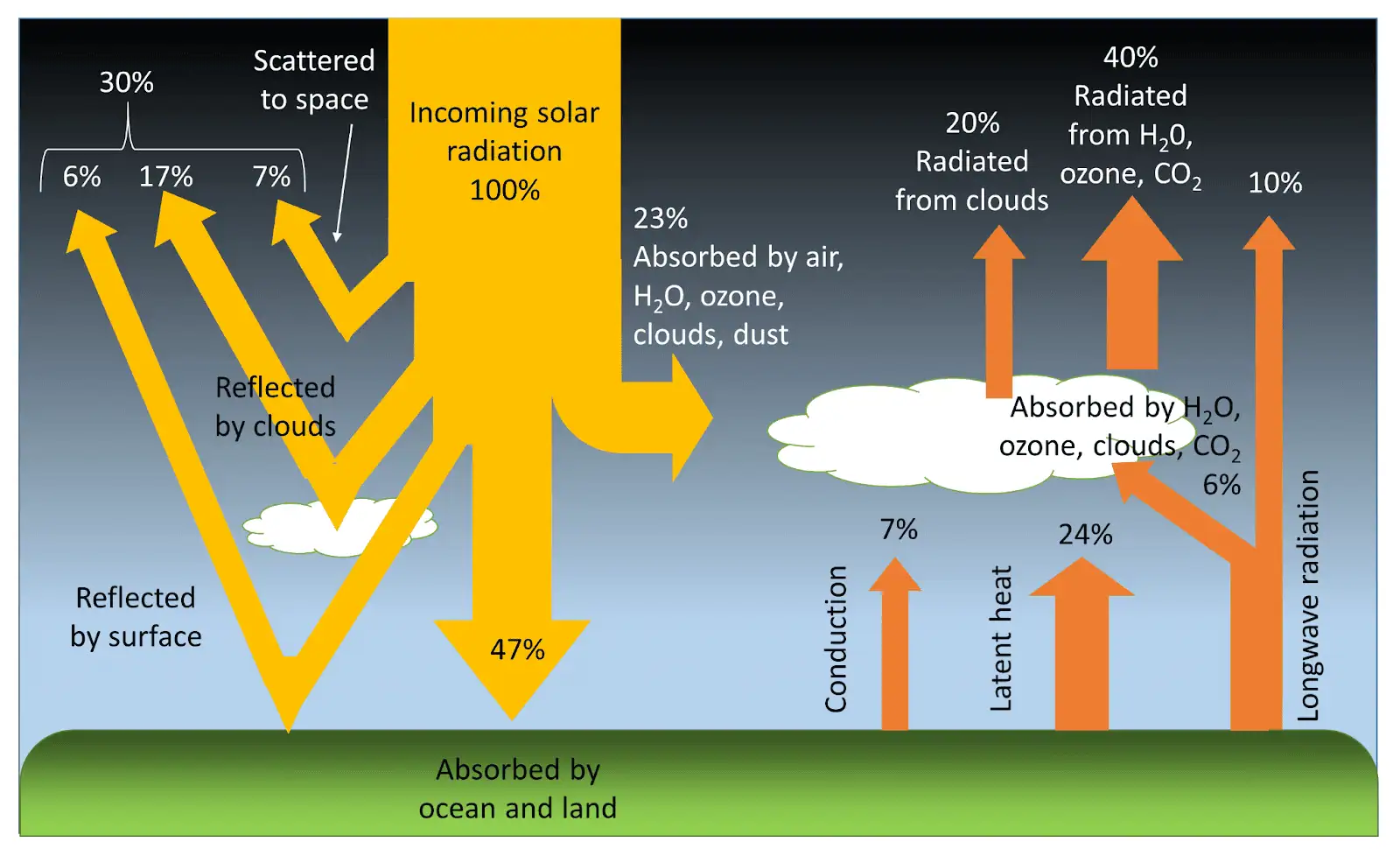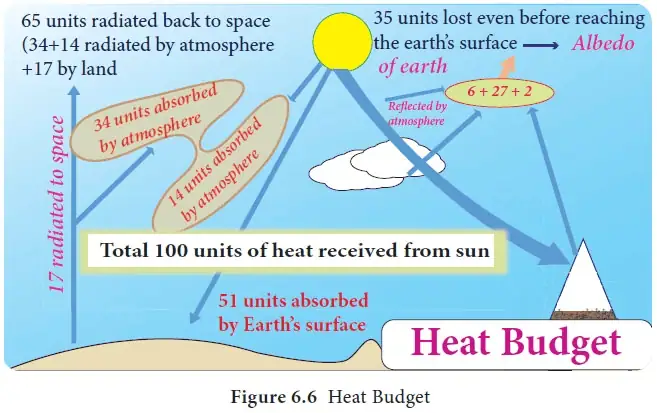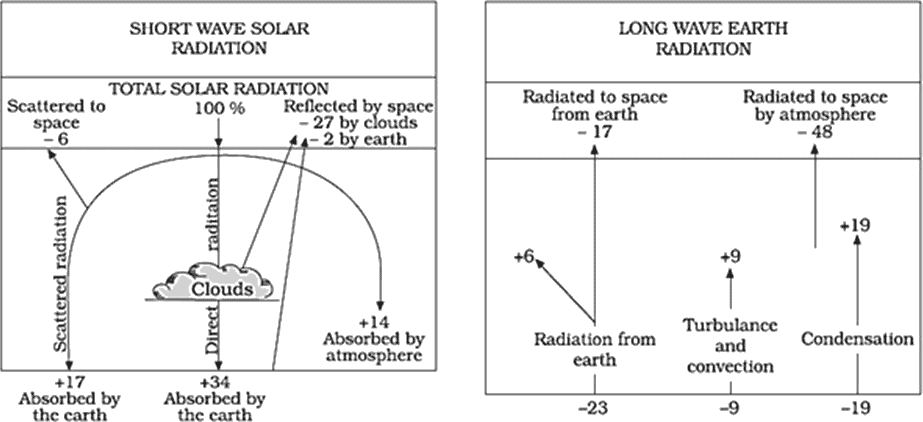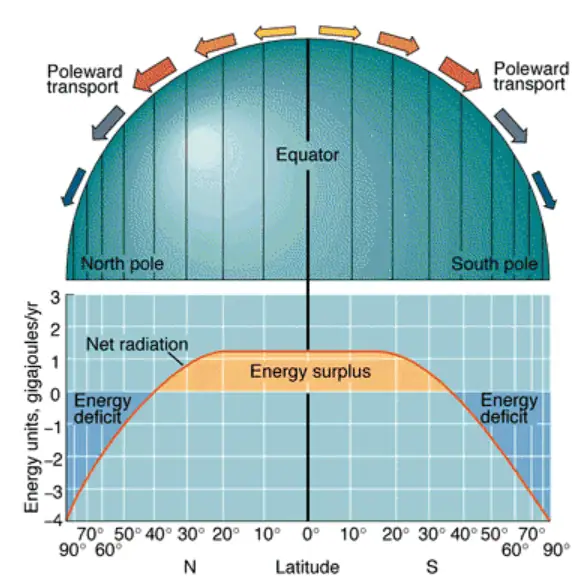Heat is a fundamental manifestation of energy, transmitted across the vast expanse of space from the sun to the Earth. This transfer of thermal energy gives rise to the concept of the Heat Budget, a principle central to understanding Earth’s intricate climate dynamics. The Heat Budget encompasses the intricate interplay of the heat energy that Earth absorbs from the sun and how this energy is allocated within the Earth’s atmospheric and terrestrial systems.
Within this framework, the Earth’s surface and its atmosphere function as active participants in the circulation and redistribution of thermal energy. The sun radiates an immense amount of energy, much of which is absorbed by the Earth’s atmosphere and surface. This absorbed energy has several fates: some of it is utilized for various atmospheric and oceanic processes, such as evaporation, convection, and the powering of weather systems, while another portion is reflected back into space.
The concept of the Heat Budget crucially explains the phenomenon of thermal equilibrium that characterizes our planet’s climate. Despite the vast influx and efflux of heat energy, the Earth maintains a remarkable balance between heat gained and heat lost. This equilibrium results in a relatively stable temperature over time. In essence, the Earth’s Heat Budget provides the necessary framework for comprehending why our planet doesn’t experience drastic and uncontrollable temperature fluctuations. Instead, the complex interactions of solar energy absorption, atmospheric circulation, ocean currents, and terrestrial heat exchange work in harmony to maintain an environment suitable for life.
the Heat Budget concept unveils the intricate choreography of how heat energy is acquired from the sun, distributed within Earth’s atmospheric and surface systems, and utilized in various processes without leading to drastic temperature swings. It is a fundamental principle that underscores the dynamic equilibrium of Earth’s climate, showcasing the delicate balance that permits life to thrive amidst the vast cosmic forces at play.
What is Heat Budget of Earth?
A heat budget represents an ideal equilibrium achieved when the heat received by the Earth from incoming solar radiation (insolation) is precisely matched by the heat emitted from the Earth’s surface in the form of terrestrial radiation. This balance is maintained by the Earth’s intricate interplay of energy absorption and emission.
Should this equilibrium falter, resulting in an excess of incoming or outgoing heat, the Earth’s temperature would deviate, leading to either excessive warming or cooling. However, due to the meticulous balance maintained, the Earth’s temperature remains within a moderate range – not excessively hot nor extremely cold.
This equilibrium hinges on the harmonious interaction of shortwave solar radiation (insolation) and longwave terrestrial radiation. The intricate equilibrium between these two opposing energy flows is referred to as the Earth’s heat budget.

The atmospheric heat budget comprises a composite of the following elements:
- 34% originates from the emission of long-wave terrestrial radiation leaving the Earth’s surface.
- 48% results from the absorption of solar radiation.
- 14% emerges from the interaction with shortwave radiation, which enters as solar radiation.
Importance of Heat Budget of Earth
- The Earth’s heat balance is vital for its habitability, achieved through the heat budget.
- This balance maintains the Earth’s warmth, contributing to its livable conditions.
- Crucial for optimizing solar panel production, which captures and transforms solar energy.
- Drives temperature variations across latitudes, shaping differences from equator to poles.
- Facilitates photosynthesis and thereby supports plant growth.
- Governs diverse rain patterns, creating variations spanning equator to poles.
Component of heat budget of earth
Radiation can be classified into two distinct categories based on their wavelength: Insolation and terrestrial radiation. Insolation comprises shortwave radiation, characterized by shorter wavelengths encompassing ultraviolet (UV) and visible light. In contrast, terrestrial radiation, often referred to as longwave radiation, comprises longer wavelengths predominantly found in the infrared (IR) spectrum.
Comprehending the Earth’s heat budget components is vital to grasp intricate phenomena such as temperature fluctuations, heat transfer mechanisms, and the influence of human activities on the global climate system.
- Insolation:
Insolation pertains to the solar radiation the Earth’s surface receives through shortwave rays. The mechanisms through which insolation participates in heat equilibrium maintenance include:
- Reflection:
This phenomenon occurs when solar waves bounce off various surfaces within the atmosphere, land, or water, without undergoing conversion into heat. Reflective surfaces, such as snow and ice, contribute to this process.
- Absorption:
Absorption is the transformation of incoming electromagnetic radiation into thermal energy. Different surfaces, including land, water bodies, and vegetation, absorb solar energy to varying degrees. This absorbed energy warms the respective surfaces, leading to temperature changes.
- Scattering:
Scattering involves the dispersion of solar waves in multiple directions upon interacting with small particles or objects in the Earth’s atmosphere, such as air molecules, water droplets, or aerosols. This phenomenon contributes to the scattering of sunlight, causing phenomena like the blue color of the sky during daylight hours.
- Terrestrial Radiation:
Terrestrial radiation, or longwave radiation, constitutes the heat energy emitted by the Earth’s surface as a response to its temperature. This process is pivotal in maintaining the heat budget equilibrium:
- Radiative Cooling:
As the Earth’s surface absorbs solar energy and warms, it subsequently emits longwave radiation to achieve thermal equilibrium with its surroundings. This radiative cooling helps regulate temperatures over time.
Understanding these intricate processes within the Earth’s heat budget elucidates the delicate balance that determines global climate patterns and temperature variations. By discerning the role of insolation and terrestrial radiation, scientists can dissect the factors driving climate change and make informed decisions about sustainable practices and policies.
How is the Heat Budget of Earth Analyzed and Calculated?
- Insolation received at the atmosphere’s top is 100 percent; during its passage through the atmosphere, energy experiences reflection, scattering, and absorption, with only the remaining portion reaching Earth’s surface.
- Approximately 35 units of energy are reflected into space before reaching the Earth’s surface. Of these, 27 units are reflected from cloud tops, while 2 units originate from snow and ice-covered regions. This reflected energy contributes to the Earth’s albedo, a measure of reflectivity.
- Earth emits 51 units as terrestrial radiation, with 17 units directly emitted to space. The remaining 34 units are absorbed by the atmosphere: 6 units are directly absorbed, 9 units via convection and turbulence, and 19 units through latent heat of condensation.
- The Earth’s surface absorbs 65 units in total, with 14 units absorbed within the atmosphere and 51 units by the Earth’s surface itself.
- The atmosphere absorbs 48 units of energy (14 units from insolation and 34 units from terrestrial radiation), which are subsequently emitted back into space.
- Consequently, the sum of radiation returning from Earth and the atmosphere is 17 units and 48 units, respectively, resulting in a balanced total of 65 units. This equilibrium matches the initial 65 units obtained from the sun.
Significance of Earth’s Heat Budget
- The heat budget holds immense importance by regulating Earth’s temperature to sustain life and influencing processes like solar energy generation, temperature shifts, and fostering plant growth via photosynthesis.
- Diverse latitudinal regions experience varying net heat budget patterns. In the tropical zone, insolation surpasses terrestrial radiation, resulting in heat surplus. Conversely, the polar zone grapples with a heat deficit, where heat loss outweighs gain, creating a latitudinal heat imbalance.
- To rectify this imbalance, winds and ocean currents become pivotal players, redistributing heat from surplus regions to deficit areas. This mechanism establishes a more uniform heat distribution, mitigating inequities among latitudes.

Working of Heat Budget of Earth
Approximately 30% of the solar energy arriving on Earth encounters reflection from its atmosphere, clouds, and surface, thus being redirected back into space. Another 23% is absorbed by atmospheric elements like water vapor, clouds, and dust, which undergo conversion into heat.
Solar radiation finds its assimilation in Earth’s oceans and landmasses, resulting in the warming of the planet’s surface. The atmosphere experiences energy transfer through radiation, conduction, and latent heat mechanisms, as energy absorbed by the Earth makes its way upward.
Understanding the Earth’s heat budget involves considering the initial receipt of 100% insolation at the atmosphere’s uppermost layer. As this energy passes through, some gets reflected, some absorbed, and some scattered, with only a portion eventually reaching the Earth’s surface.
Approximately 35 units of energy are reflected back to space, with 27 units attributed to cloud reflection and 2 units from ice-covered areas on Earth. This collective reflected energy is termed the Earth’s albedo.
Around 48 units of energy are absorbed by the atmosphere, with a fraction subsequently radiated back into space. Consequently, the total radiation returning from Earth sums up to approximately 65 units. The equilibrium between incoming and outgoing heat defines the Earth’s stable heat budget, maintaining its overall temperature balance.
Variation in the Heat Budget of Earth

- Earth’s equilibrium between insolation and terrestrial radiation varies by latitude.
- In the tropical zone, insolation and heat budget surpass terrestrial radiation, leading to heat surplus.
- Conversely, the polar zone experiences more heat loss than gain, resulting in a heat deficit.
- These disparities create heat imbalances across latitudes.
- Winds and ocean currents intervene, moving heat from surplus regions to those with deficits, partially restoring balance.
- This process of equalizing heat distribution across latitudes is known as latitudinal heat balance.
Heat Budget of Earth – Incoming Solar Energy & Outgoing Solar Energy
Incoming solar energy :
- Incoming solar energy denotes the total energy Earth receives per second at its atmosphere’s top.
- This energy increment contributes to the overall heat budget and is termed short-wave radiation, measured in watts.
- Earth’s spherical shape intercepts around 340 watts per square meter, with energy absorption differing by location.
- Among the 340 watts, 77 watts per square meter is reflected back by clouds and Earth’s surface, leaving 240 watts per square meter for Earth’s solar energy budget.
- This retained energy is recognized as absorbed solar radiation, enhancing Earth’s heat balance.
Outgoing Solar Energy
- Outgoing solar energy, also termed longwave radiation, signifies the complete energy departing Earth.
- Energy absorption results in various forms of heat energy, including emission as OLR (outgoing longwave radiation), which is discharged into space.
- This emitted energy is deducted from the overall energy value within Earth’s heat budget.
- Earth’s energy exchange involves receiving insolation in shortwave form and releasing heat through longwave radiations. This equilibrium maintains consistent temperature and a stable Heat Budget of Earth.
- Earth’s energy dynamics adhere to the first law of Thermodynamics, stipulating that energy cannot be generated or annihilated.
Impacts of Earth’s Heat Budget on the Earth’s Climate System
- Earth’s heat budget plays a pivotal role in shaping the planet’s climate by maintaining equilibrium.
- Balanced heat budget results in stable Earth temperatures, avoiding significant overall temperature fluctuations.
- Global weather and climate variations arise due to uneven heating of Earth and its atmosphere, influenced by latitude and season.
- Imbalance between incoming and outgoing energy is caused by changing solar energy reception due to seasons and atmospheric composition.
- Variations in Earth’s atmosphere composition impact energy absorption and reflection, leading to a modest yet significant energy imbalance.
- Human activities, particularly the increase in atmospheric carbon dioxide, exacerbate this energy imbalance.
- Escalation of carbon dioxide leads to an accumulation of energy imbalance, causing Earth’s temperature to rise in response.
- Rising greenhouse gas concentrations, including carbon dioxide, are projected to intensify this discrepancy annually, contributing to temperature increases.
- Earth’s Radiative Balance: The heat budget imbalance stands as a significant driver of rising Earth temperatures, a substantial consequence of climate change.

The diagram illustrates the varying levels of insolation received by Earth’s surface. The Equator experiences consistent and significant insolation throughout the year, obtaining the highest amount globally. This Equatorial region observes minimal seasonal variations in insolation. Moving away from the Equator toward the Poles, insolation levels fluctuate seasonally and diminish.
In the Northern Hemisphere, peak insolation occurs from March to September, while in the Southern Hemisphere, it prevails from September to March. Notably, Polar Regions experience periods of zero insolation during certain times of the year.
How does the Earth’s Heat Budget maintain equilibrium?
The Earth’s Heat Budget achieves equilibrium when the amount of incoming solar energy matches the amount of heat energy radiated back into space. This equilibrium prevents significant temperature fluctuations.
What factors contribute to an imbalance in the Earth’s Heat Budget?
Seasonal variations in insolation, changes in atmospheric composition, and human activities such as increasing greenhouse gas emissions can lead to imbalances in the Earth’s Heat Budget.
How does the Earth’s Heat Budget impact climate?
The balance of the Earth’s Heat Budget affects global climate patterns. When there is an imbalance, it can lead to changes in temperature, weather patterns, and other climatic phenomena.
What role do winds and ocean currents play in the Heat Budget?
Winds and ocean currents help redistribute heat from regions of surplus to those with deficits, helping to mitigate imbalances and regulate temperature variations across the Earth.
How does the Earth’s Heat Budget influence temperature variations across latitudes?
The Earth’s Heat Budget contributes to temperature differences from the equator to the poles. Equatorial regions receive more direct sunlight, resulting in higher temperatures, while polar regions experience oblique sunlight and cooler temperatures.
Also Read:- Climate Of India (Important Notes For APSC)